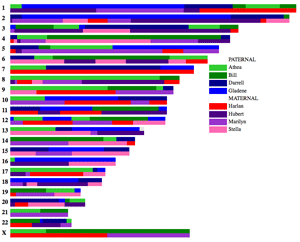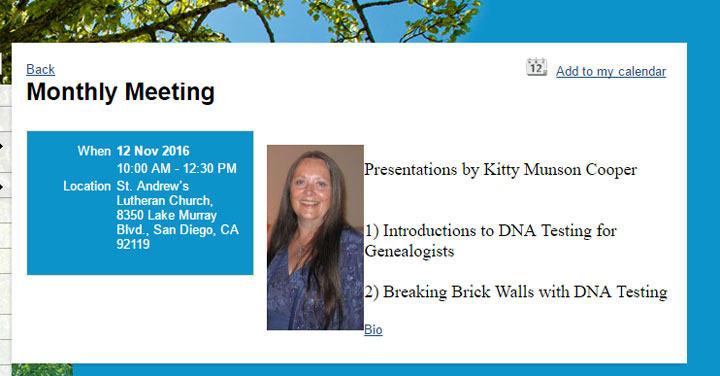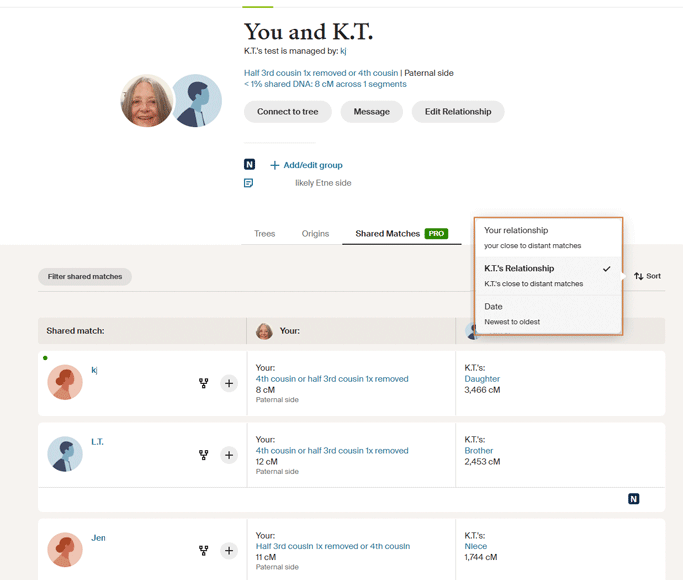Overview of DNA and chromosomes
We each have 23 pairs of chromosomes containing DNA plus we have some more DNA that can be tested in our mitochondria (mtDNA), the little organisms that make a cell’s energy. In human DNA, chromosomes 1 through 22 recombine for reproduction.
 A child gets one copy of each chromosome from each parent, thus a pair. However all of these first 22 chromosomes will be a mix of the genes from that parent’s parents. The DNA from the parent’s two copies of each chromosome is randomly recombined to make a single new version of that chromosome which is then passed on. This way siblings can inherit quite different DNA from their parents although normally they share about 50% with each other (see the diagram in my blog post for the comparison between me and my brother, we share 47%).
A child gets one copy of each chromosome from each parent, thus a pair. However all of these first 22 chromosomes will be a mix of the genes from that parent’s parents. The DNA from the parent’s two copies of each chromosome is randomly recombined to make a single new version of that chromosome which is then passed on. This way siblings can inherit quite different DNA from their parents although normally they share about 50% with each other (see the diagram in my blog post for the comparison between me and my brother, we share 47%).
A really lovely example of four generations of DNA inheritance was done by Angie Bush for a presentation and discussed in one of my blog posts. The image here, which shows the eight known sources of her daughter’s DNA, was made by Angie.
The X and the Y: the 23rd chromosome pair
The 23rd chromosome pair is either an XX for a girl or an XY for a boy. One X chromosome will be a recombined mixture from the mother’s parents but the second X for a girl is an unrecombined X from her father (recombined by her father’s mother) since he has only one X chromosome to pass along to her. To his sons he passes a Y which is what makes them boys not girls.
The fact that the X does not get recombined by fathers means that matches on the X chromosome can reach much further back in time than the other chromosomes, since they may not have been recombined as often. Another thing to note about the X is that a number of conditions like hemophilia, color blindness, and baldness are governed by recessive genes on the X so are infrequent in women who need two copies of that gene as compared to men who need only one copy since the Y is a blank for those genes. This type of gene is called sex-linked.
The Y chromosome has no second Y to recombine with, so it is passed from father to son with almost no change other than mutations. This makes the DNA on the Y chromosome very useful to test for genealogy purposes. The Short Tandem Repeat (STR) count on the Y changes frequently enough, every few hundred years or so, for paternal line (paternity) testing whereas the Single-nucleotide polymorphism (SNP) mutations on the Y are more indicative of deeper ancestry in the thousands of years. Since the mitochondria only come from the mother, mtDNA testing gives information about the maternal line deep ancestry. Currently less useful for genealogy other than to disprove a maternal line of descent when the haplogroup does not match.
Haplogroups
The various mutations of Y chromosomes from the original common ancestor of us all have been cataloged and assigned to groups known as haplogroups. These tell you much about the locations of your thousands of years back ancestors. ISOGG maintains the most current list of Y haplogroups and has a good write up of genetic genealogy basics. There are also haplogroups for mtDNA. So the completely male or female line can be traced back into prehistory this way. Eupedia.com has a nice set of maps and origin explanations for all these haplogroups.
DNA Testing Basics for Genealogy
Because the Y chromosome and mtDNA get passed down along only one line of your ancestry, Y: fathers to sons, mtDNA: mothers to daughters, testing them is a much clearer and easy to understand process. Meg Smolenyak’s book, Trace Your Roots with DNA: Using Genetic Tests to Explore Your Family Tree is the best introduction to the use of these tests for genealogy and tracing your roots that I have found.
However autosomal DNA testing, that is testing chromosomes 1-22 for the most important markers, is the most frequent and comprehensive tool being used. This is the type of test offered by 23andme, Ancestry.com, MyHeritage.com and the family finder test at Family Tree DNA. The problem is that it is so amorphous that it is hard to understand. Autosomal DNA inheritance is quite random and becomes more so the more generations the DNA passes through which many find frustrating.
Click here for my slides from my presentation “You DNA Tested, Now What?“ which discusses ethnicity results and haplogroups, but mainly focuses on how to use your DNA results for cousin matching and genealogy. Click here for a slightly more advanced presentation “New Tools for DNA Cousin Matching“ which discusses the latest tools from the testing companies to help figure out your DNA cousin relationships.
There are a number of books on the basics of using DNA testing, but the field changes rapidly. The newest and perhaps best book these days is Blaine Bettingers’s The Family Tree Guide to DNA Testing and Genetic Genealogy. Also see my book recommendations on the DNA-NEWBIE FAQ.
I also recommend Kelly Wheaton’s series of free online lessons on Genetic Genealogy highly for learning more about DNA testing:
https://wheatonwood.com/introduction-to-genetic-genealogy-dead-people-can-talk-after-all/
Can you find new relatives with autosomal DNA testing?
To find relatives you contact the people with whom you have the most matching DNA shown at your testing company or GEDmatch. More than one matching segment of at least 7-10 cM is a good starting criteria for finding closer relatives. Single segment matches of that size can be anything from 4th cousins out to 14th cousins. Overlapping segments are the key. If you overlap with more then one person and they match each other at the same spot (called triangulation) then all three of you share an ancestor, so exchange family trees and see if you can find him or her!
Click here for my blog post on finding DNA relatives which explains how to find the matching segment data. I also did a post that shows the step by step usage of the tools at 23andme.
Personally I have had great success finding new Norwegian cousins with DNA: 3rd, 4th, 5th, 6th, and further; but very little success on my German or half Ashkenazi side. One thing I have discovered is that DNA can persist through many more generations than expected. So I googled and found a good article which I link to from my blog post on single segment matches.
The ISOGG wiki has a chart of the expected amount of DNA shared with your various relatives which is very useful in determining how close a relationship might be. The problem is that if a population is very endogamous, that relationships will appear closer than they are. This is very apparent with Ashkenazi DNA and I even sometimes find that cousins who look close in Norway are not, rather we share more than one common ancestor.
This online calculator lets you enter the centimorgans or percentage shared with a match and will give you the probability for the different possible relationships: https://dnapainter.com/tools/sharedcmv4
Testing
What is your objective in doing this testing? If it is solving a genealogical brick wall let me know how you did. I solved the one that started me on this testing path (see the post on Lars Monsen) and another one along the way. If it is curiosity and finding more relatives then enjoy and read on.
I have summarized the testing companies and my thoughts on them on my DNA testing page.
[printicon align=”right”]



